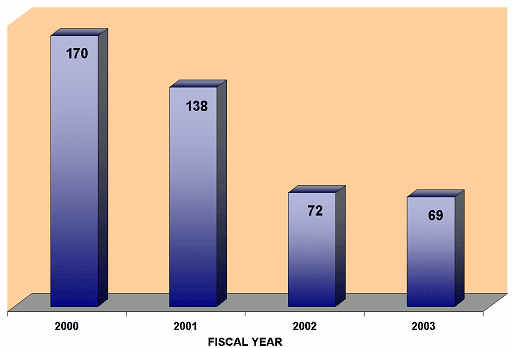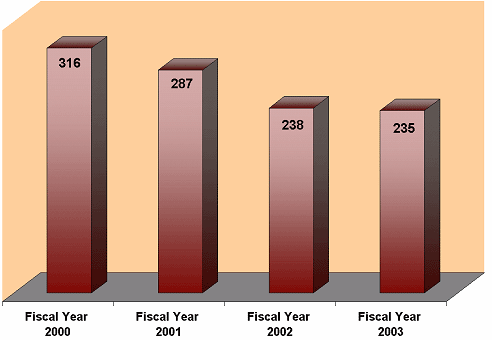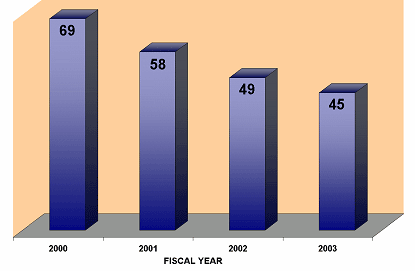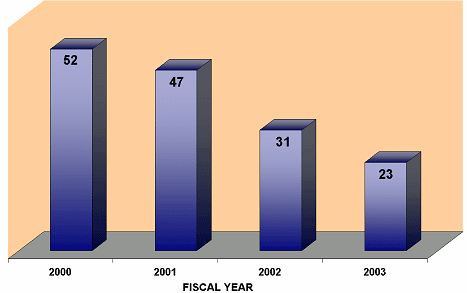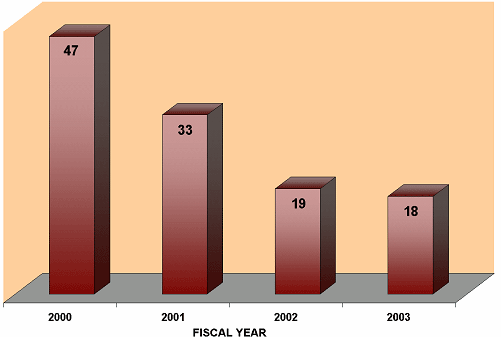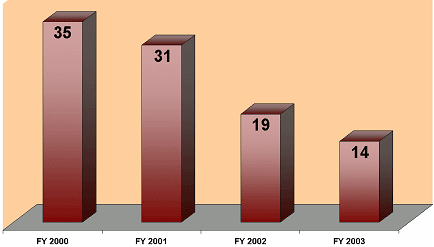|
As was the case with OC/D matters, we identified trends in the field offices most affected by agent utilization reductions in these violent crime classifications. Additionally, we reviewed changes in the number of case openings for each of the six violent crime classifications at the field office level between FYs 2000 and 2003. Our analyses of agent utilization and case openings are presented in the following sections. Classification 088A (Unlawful Flight to Avoid Prosecution - Crime of Violence) involves the investigation of fugitives charged with a violent crime. The following exhibit details the general decline in field agent resources utilized within this classification for FYs 2000 through 2003. TOTAL FBI FIELD AGENT RESOURCE UTILIZATION
Field Offices - The following exhibit shows the changes that occurred within all FBI field offices. As shown, several offices experienced significant resource utilization reductions in this fugitive area, many of which were among the FBI's larger offices. CHANGES IN ON BOARD AGENTS IN FBI FIELD OFFICES
Besides the reductions in field agent utilization, this investigative area experienced the greatest reduction in case openings, by far, of any other classification identified in the top 30 decreasing classifications. The FBI opened 13,384 violent fugitive investigations in FY 2000, but reduced that to only 1,767 in FY 2003. This significant drop in case openings amounts to a decrease of 87 percent. The following table lists the field offices that experienced a reduction of at least 25 case openings. As seen from the list, 42 of the FBI's 56 field offices opened significantly fewer violent fugitive cases in FY 2003 than in FY 2000. Notably, the New York City Field Office, after opening 376 violent fugitive cases in FY 2000, opened none in FY 2003.
Between FYs 2000 and 2003 the number of agents working on bank robbery investigations significantly dropped. The following exhibit provides an overview of the on board agents involved in such investigations during this period. TOTAL FBI FIELD AGENT RESOURCE UTILIZATION
Field Offices - Changes in agent utilization of all field offices in 091A matters are highlighted in the following exhibit. As shown, virtually every office had some sort of on board agent reduction. Furthermore, many of the significant utilization declines occurred in the FBI's larger field offices, like Chicago and Los Angeles. CHANGES IN ON BOARD AGENTS IN FBI FIELD OFFICES
In our review of casework in 091A matters, we found that although 3 field offices opened at least 111 fewer cases in FY 2003 than FY 2000, 091A case openings in the majority of FBI field offices increased during this timeframe. Field offices experiencing the greatest reductions in cases openings in this classification are highlighted in the following exhibit.
Another violent crime classification that experienced a reduction in field agent resource utilization was Classification 244 (Hostage Rescue Team). The following exhibit illustrates the decline in the number of on board agents involved in these investigative matters between FYs 2000 through 2003. TOTAL FBI FIELD AGENT RESOURCE UTILIZATION
Field Offices - When analyzing the resource utilization changes at the field office level, we found that no office experienced significant fluctuations (whether increasing or decreasing) in on board agents. Instead, the majority of the utilization reduction in 244 matters occurred within the Critical Incident Response Group (CIRG), which provides tactical support to FBI field offices for incidents ranging from hostage rescue to fugitive apprehension. Thus, it was not surprising that CIRG accounted for a large portion of the overall reduction in this investigative classification. Interstate Transportation of Stolen Property Resource utilization for investigations involving the transportation of stolen property across state lines valued at $25,000 or more are tracked in Classification 087B (Interstate Transportation of Stolen Property - $25K+). This violent crime area was also among the 30 classifications experiencing significant field agent resource utilization reductions. The following exhibit provides the on board agents utilized in this investigative area between FYs 2000 through 2003. TOTAL FBI FIELD AGENT RESOURCE UTILIZATION
Field Offices - The following exhibit represents the agent resource utilization changes among FBI field offices. As illustrated, the majority of offices experienced on board agent reductions involving investigations of 087B matters. Additionally, the greatest agent utilization declines occurred in the FBI's larger field offices: Baltimore, Dallas, New York City, Phoenix, and Washington. CHANGES IN ON BOARD AGENTS IN FBI FIELD OFFICES
As shown in the following exhibit, three of the field offices experiencing the greatest reductions in 087B case openings (Chicago, Los Angeles, and Dallas) were among the largest FBI field offices.
Interstate Transportation of Stolen Motor Vehicles Classification 026B (ITSMV - Commercial Theft or Chop Shops) was another investigative area involving violent crime that experienced a significant reduction in field agent resource utilization. The overall number of on board agents working on these matters from FYs 2000 through 2003 is shown in the following exhibit. TOTAL FBI FIELD AGENT RESOURCE UTILIZATION
Field Offices - Changes in agent utilization within each FBI field office are highlighted in the following exhibit for investigations involving 026B matters. Although some field offices actually had utilization increases in this area, the changes were nominal. In turn, the majority of the offices experienced on board agent reductions, with the most significant declines occurring in larger offices with the exception of El Paso and Knoxville. CHANGES IN ON BOARD AGENTS IN FBI FIELD OFFICES
Within 026B investigative matters, we determined that the greatest reduction in case openings in any one field office was only eight. However, nearly all of the offices listed as experiencing the greatest reductions in case openings did not open any 026B investigations in FY 2003.
Theft From Interstate Shipment Of the six violent crime classifications experiencing significant field agent resource utilization reductions, the final one identified was Classification 015B (TFIS - Loss of $25K+; Weapons, Explosives). The following exhibit illustrates the on board agents involved in this investigative area from FYs 2000 through 2003. TOTAL FBI FIELD AGENT RESOURCE UTILIZATION
Field Offices - We found that several FBI field offices experienced some sort of reduction in on-board agents from FYs 2000 to 2003, as depicted in the following graph. Many of the changes were nominal; however, we did note that four of the FBI's six largest field offices experienced the most significant field agent utilization declines. CHANGES IN ON BOARD AGENTS IN FBI FIELD OFFICES
Our analysis of Classification 015B revealed that the FBI overall opened 241 fewer cases in FY 2003 than in FY 2000. The following exhibit details those field offices with the greatest reductions in case openings in 015B matters.
Footnotes
Redacted and Unclassified |
|||||||||||||||||||||||||||||||||||||||||||||||||||||||||||||||||||||||||||||||||||||||||||||||||||||||||||||||||||||||||||||||||||||||||||||||||||||||||||||||||||||||||||||||||||||||||||||||||||||||||||||||||||||||||||||||||||||||||||||||||||||||||||||||||||||||||||||||||||||||||||||||||||||||||||||||||||||||||||||||||||||||||||||||||||||||||||||||||||||||||||||||||||||||||||||||||||||||||||||||||||||||||||||||||||||||||||||||||||||||||||||||||||||||||||||||||||||||||||||||||||||||||||||||||||||||||||||||||||||||||||||||||||||||||||||||||||||||||||||||||||||||||||||||||||||||||||||||||||||||||||||||||
